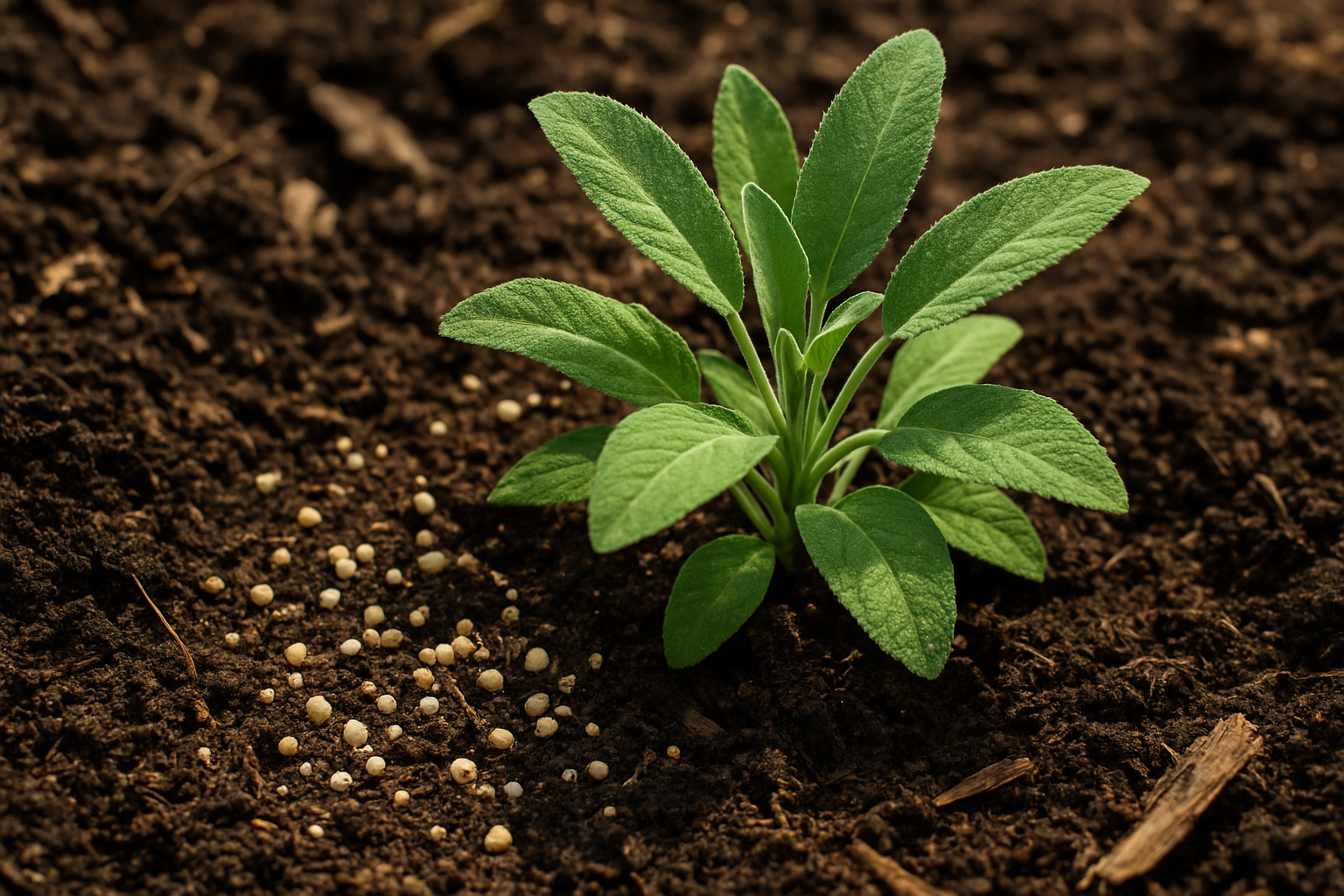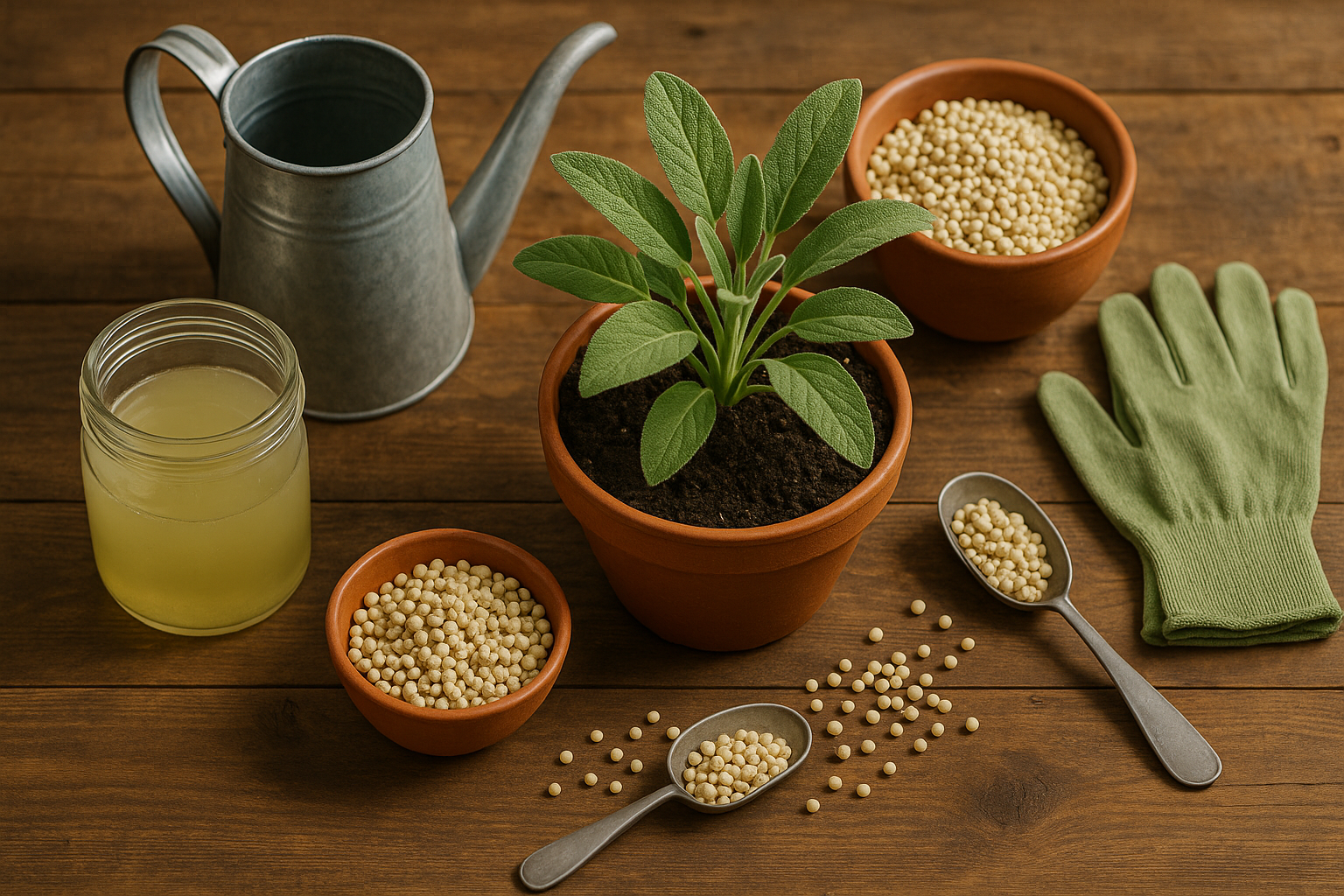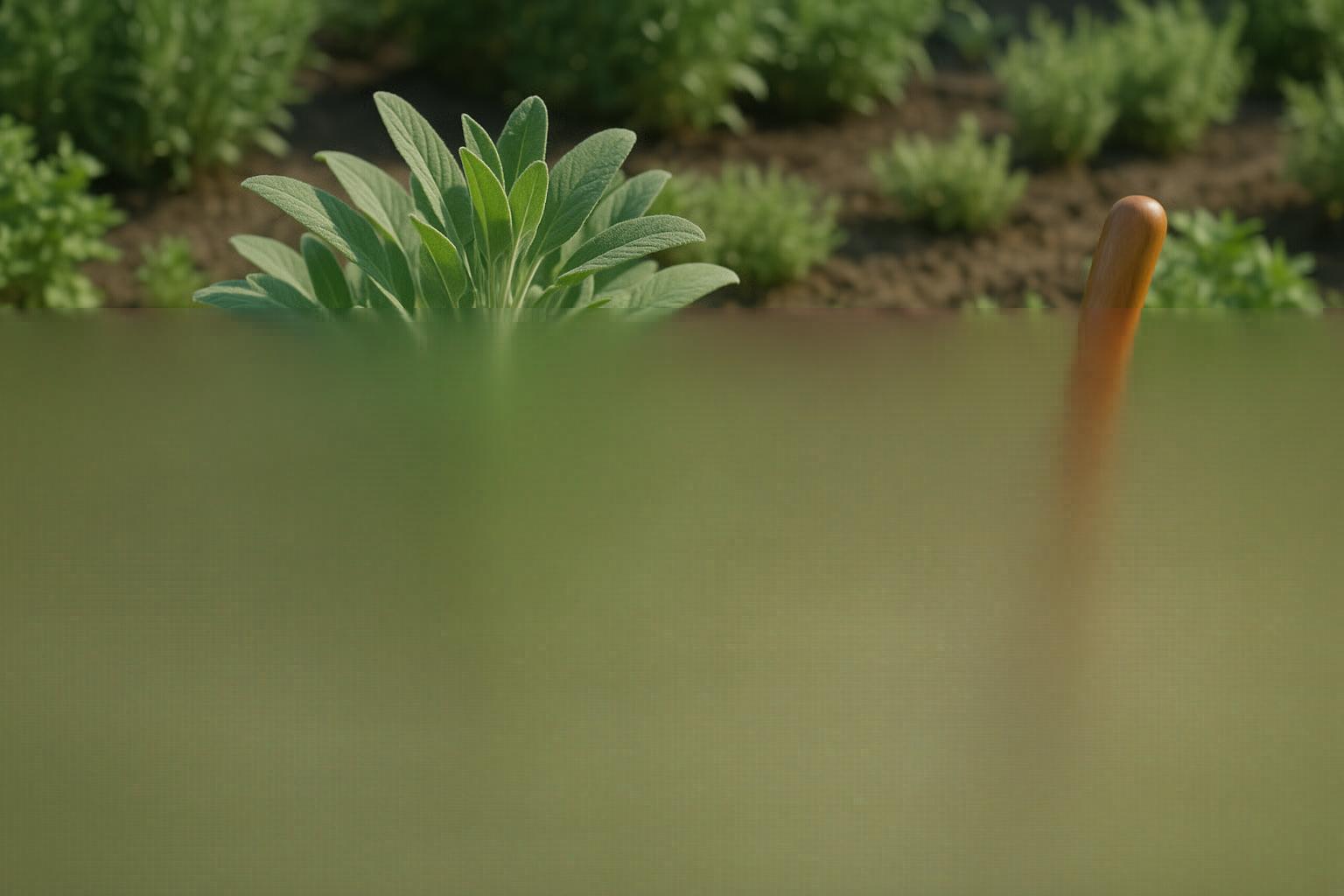Understanding Sage’s Nutritional Needs

Sage may be known for its hardiness and ability to thrive in less-than-perfect conditions, but providing proper nutrition can make a real difference in how well it grows, tastes, and looks. Even though sage can survive with minimal care, offering balanced nutrition helps the plant produce more abundant, flavorful leaves, better resist pests and disease, and live a longer, healthier life.
Sage relies on essential nutrients, with nitrogen supporting leafy growth, phosphorus encouraging strong root systems and abundant blooms, and potassium boosting overall plant health and stress tolerance. Trace minerals like calcium, magnesium, and iron also play vital roles, preventing issues like yellowing leaves or stunted plants.
The quality of the soil heavily influences how well sage can access these nutrients; well-draining, slightly alkaline soil rich in organic matter supplies both nutrients and good structure for root health. If the soil is depleted or compacted, even hardy herbs like sage will struggle—it’s wise to amend garden beds with compost or aged manure each season.
If you’re growing sage in containers, the nutrient demands can be a bit different. Pots tend to dry out and lose nutrients faster, so using a premium potting mix and feeding sage with a diluted, balanced liquid fertilizer every few weeks during the growing season keeps the plant vigorous.
In contrast, in-ground sage may require less frequent fertilization if the garden bed is maintained, but still benefits from an annual top dressing of compost or slow-release fertilizer.
By understanding sage’s nutritional needs and optimizing its growing environment, whether in pots or in the ground, you’ll enjoy healthier, more productive herbs all season long.
When and How Often to Fertilize Sage
Fertilizing sage at the right time is key to encouraging healthy, flavorful leaves without overwhelming this hardy herb. The best time to feed sage is in the spring, once new growth appears and the risk of frost has passed. This is when the plant is coming out of dormancy and can best utilize nutrients for leafy growth.
For a simple schedule, mature sage plants benefit from one light application of a balanced, slow-release fertilizer or a thin layer of compost just as the growing season begins. You can repeat this once more in mid-summer if your soil is poor or the plants look pale, but over-fertilizing can lead to lush foliage with less flavor and fewer essential oils.
Seedlings and young plants, being more delicate, require even less: a half-strength diluted liquid fertilizer once monthly during their first summer is more than enough to support healthy root and leaf development.
As the season turns to late summer or early fall, stop fertilizing entirely. This pause gives the plant time to harden off and prepare for winter dormancy, reducing tender growth that might be damaged by the cold.
By focusing your fertilizing efforts on the spring and early summer, and dialing back by late summer, you help your sage thrive and stay robust year after year, whether you grow it in the ground or in a container.
Choosing the Right Fertilizer for Sage
When it comes to fertilizing sage, a mindful approach can make a world of difference in plant health and flavor. Organic fertilizers like compost and fish emulsion are excellent choices—they release nutrients slowly, encourage beneficial soil life, and limit the risk of overfeeding.
In contrast, synthetic fertilizers offer quick results but can easily overload sage if not applied carefully, sometimes leading to excessive leafy growth with subdued flavor. Sage thrives best with a balanced or low-nitrogen fertilizer, ideally with an N-P-K ratio around 5-5-5 or 4-8-6. Avoid high-nitrogen formulas, such as those marketed for lawns; too much nitrogen encourages lush growth at the expense of essential oils that give sage its distinctive aroma and taste.
Feed with moderation, applying fertilizer once in early spring and possibly again in midsummer, but don’t over-fertilize—sage is fairly drought-tolerant and prefers lean soils. Homemade options like well-rotted compost, diluted compost tea, or even crumbled eggshells and coffee grounds offer gentle, eco-friendly nourishment that aligns perfectly with sustainable gardening practices.
Steer clear of chemical-heavy feeds and focus instead on enriching your soil slowly and naturally. This supports healthy sage plants and the wider garden ecosystem.
How to Fertilize Sage — Step-by-Step Techniques

When fertilizing sage, start by choosing the right type of fertilizer—either a balanced granular or a mild liquid formulation works well. Avoid anything too nitrogen-heavy, as this can reduce the plant’s flavor and aroma.
For in-ground sage, if using granular fertilizer, sprinkle a small, measured amount (about one tablespoon per mature bush, or half that for young plants) evenly around the base, keeping it several inches away from the stem. Lightly scratch the granules into the top inch of soil.
If using a liquid fertilizer, dilute it to half-strength according to the product label. Slowly pour the solution at the base of the plant, ensuring it soaks into the root zone rather than splashing onto the leaves.
For young sage, fertilize once just after planting and again midway through the growing season. Mature bushes typically only need feeding once in early spring.
When growing sage in containers, use even less fertilizer—roots are confined, so nutrients don’t need to travel far. Apply a pinch of granular feed or a very diluted liquid fertilizer every six to eight weeks during the active growing period, but stop once growth slows.
Before fertilizing, water your sage thoroughly; this prevents root burn and helps nutrients spread evenly. After applying fertilizer, water again to move nutrients into the root zone—especially crucial in pots, where salts can build up from fertilizer use.
Pay attention to your plant’s signals: yellowing foliage may indicate overfeeding, while stunted growth often points to undernourishment.
Regular but moderate feeding, tailored to your sage’s age and growing location, will keep it robust and ready for harvesting, whether in the garden or on your kitchen windowsill.
Recognizing and Troubleshooting Fertilization Problems
Spotting the early signs of fertilization problems can save your plants from unnecessary stress and even death. Common indicators of nutrient deficiencies include yellowing leaves (often starting at the tips or between the veins), stunted or slow growth, and poor flowering or fruiting. You might also notice purpling leaves (a sign of phosphorus deficiency) or curling edges (potassium deficiency).
On the other hand, symptoms of over-fertilization often look different. Key signs include burned, crispy leaf edges, blackened or “burned” roots, and leggy or floppy stems.
It’s important to respond quickly:
- If you suspect a deficiency, choose a balanced, water-soluble fertilizer and apply it at half the recommended dose, gradually increasing if the plant responds well.
- For over-fertilization, flush the soil with plenty of clean water to wash away excess salts, and avoid fertilizing for a few weeks while your plant recovers.
However, not all problems come from fertilization. Overwatering, poor soil drainage, or pest infestations can cause similar symptoms like yellow leaves or slowed growth. Always check that your plant’s container has proper drainage holes, the soil isn’t soggy, and roots aren’t sitting in water. You can lift your plant out of the pot to inspect root health and look for signs of pests or disease.
By staying observant and adjusting your care routine, you can quickly distinguish fertilization issues from other problems and help your plants thrive.
Avoiding Over-Fertilization — Protecting Flavor and Quality
Over-fertilizing your sage plants might seem like a quick way to get lush growth, but it often does more harm than good. Too much fertilizer can cause root burn, resulting in yellowed or wilted leaves and stunted development. Even worse, overfeeding sage floods the plant with nutrients and water, which dilutes its essential aromatic oils—the very compounds responsible for its distinctive flavor and many medicinal benefits. This means your carefully tended sage could end up tasting bland, losing its therapeutic punch, and lacking that signature fragrance you love.
To protect both flavor and quality, stick with a minimalist approach: apply only slow-release fertilizers and always follow the package directions. Test your soil regularly with an easy-to-use home kit so you know when (and if) nutrient levels need a boost, rather than guessing. Most established sage plants thrive with just a light spring feeding or a side-dress of compost.
When in doubt, less is more; sage evolved to flourish in poor soils with limited feeding, so restraint almost always yields tastier, more potent leaves. By resisting the urge to over-fertilize, you’ll nurture hardy, aromatic plants that deliver peak culinary and herbal value.
How Fertilizer Affects Blooming, Aroma, and Harvests
Proper fertilization is key to unlocking your garden’s true potential, enhancing leaf yield, vivid color, and the strength of your plants’ unique aromas. Using the right amount and type of fertilizer helps plants grow lush and healthy, producing more leaves and richer hues—think deep green basil or vibrant purple lavender.
Stronger aroma also comes from well-nourished plants, thanks to optimal nutrient levels that support oil and terpene production. However, it’s tempting to overfeed in hopes of bigger harvests, but this often backfires. For example, excess nitrogen can lead to abundant leafy growth while diluting flavor and aroma, making herbs taste bland and less fragrant.
To maximize both harvest size and quality, start with a soil test and choose a balanced, slow-release fertilizer. Feed plants according to their specific needs and growth cycle—for instance, reduce nitrogen as flowering begins to help the plant focus on developing oils and blooms rather than just leaves.
Monitor leaf color and scent regularly:
- Pale leaves may indicate a nutrient deficiency.
- Overly lush, floppy leaves can signal excess nutrients.
Adjust feeding schedules seasonally and avoid fertilizing just before harvesting to preserve essential oil concentrations, ensuring the best aroma and taste.
Beyond Fertilizer — Complete Sage Care Reminders (Optional Conclusion)
While nutrition is key, thriving sage also depends on plenty of sunlight, regular pruning, and good soil drainage. Remember that every sage plant is a little different—try adjusting your watering schedule or pruning style, and watch how your plant responds.
You might find your sage prefers morning sun or that trimming more often encourages bushier growth. Don’t be afraid to experiment and learn from your plant’s unique needs. With a bit of attention to all aspects of care, you’ll enjoy abundant, fragrant sage leaves perfect for your kitchen and a delight in the garden.
